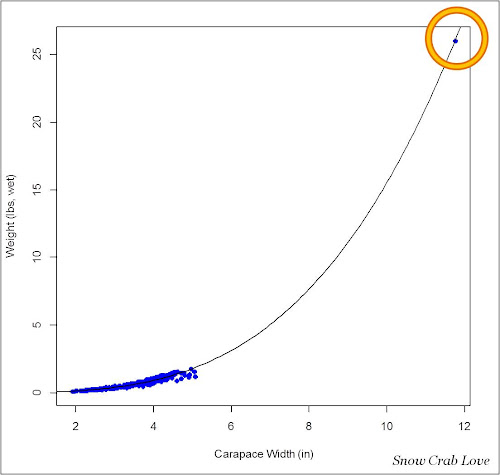King crabs are blue,
Poems are hard,
Bacon.
Poems are hard,
Bacon.
It's time to answer another crab chat question:
What's the difference between red and blue king crabs (aside from color)?
Red king crabs and blue king crabs have 4 pairs of legs (6 walking legs and two claws) unlike snow crabs and Tanner crabs, which have 5 pairs of legs. The neat thing about kings is that they're NOT symmetrical! Think about your average crab (or human, horse, dog, fish, etc): when you visually slice it in half, each side is the same, albeit opposite. But not our friends, the king crabs! They have asymmetrical abdomens which are possibly derived from hermit crab ancestors (remember how hermit crab abdomens curve to the left, to the left?) (Remember how I'm cool because I reference Beyoncé songs in my nerdy crab blog?
A female king crab's abdominal flap is made up of 7 segments,
but they aren't all the same shape or size!
That's what they have in common, but you wanted to know what makes them different. One of the main differences, aside from color, is size. Blue king crab males can grow up to 18 pounds, which is pretty awesome for any crab, but red king crab males can get even bigger: up to 24 pounds with a leg span of 5 feet! Another physical difference is the number of spines they have on their rather spiny carapace. If you focus in on just the mid-dorsal plate of the king crab carapace, you'll notice a grouping of prominant spines. When you count 4 spines, you're looking at a blue king crab; you've got a red king crab when you count 6 spines. Now, this is not always true (there are rebel crabs out there that don't like to live by the rules and will rock 5 spines), but when in doubt, do a quick count! For example, I shared this photo of a king crab my husband came across that had been baking in the sun in Russia:
I foolishly just called it a red king crab (because I, equally foolishly, thought they only had red kings in Russia), but was promptly corrected. On closer investigation, I could see the 4 mid-dorsal spines!
Blue king crab it is!
That geographical mistakes leads me to another difference: while we can find both red and blue king crabs in Alaskan waters, their distributions are pretty different. Red king crabs are pretty well spread out with open commercial or personal use fisheries in southeast Alaska, Bristol Bay, and Norton Sound. Blue king crabs have a patchier distribution and their populations have such low numbers that all of their fisheries are closed.
maps from Alaska Department of Fish and Game
Of course, considering all of these differences, it's still pretty awesome to see how brilliantly blue a blue king crab is compared to its red cousin!
One crab, Two crab, ↑Red crab, ↓ Blue crab
A good field guide (and the source of the abdomen pictures):
Donaldson, W. E., and S. C. Byersdorfer. 2005. Biological Field Techniques for Lithodid Crabs. University of Alaska Sea Grant. AK-SG-05-03, Fairbanks.















